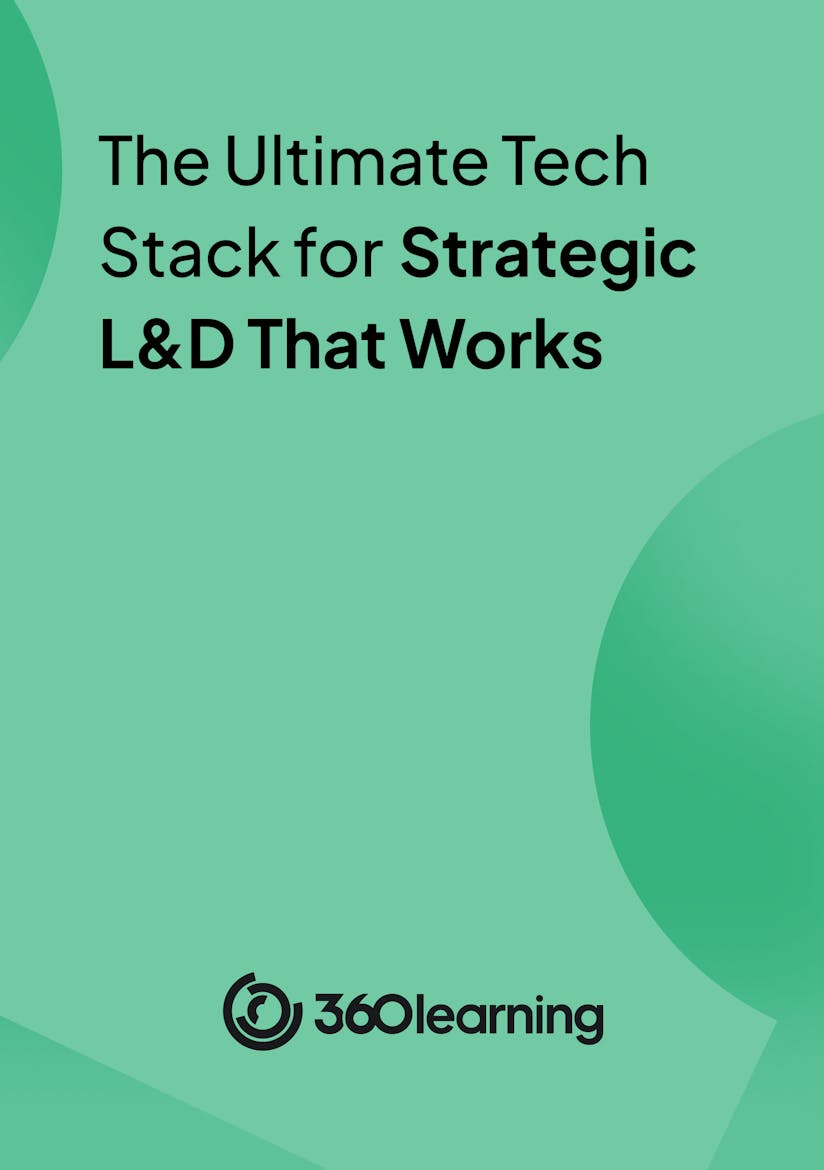
Artificial intelligence (AI) continues to impact many aspects of life—including learning and development (L&D).
With tools like ChatGPT, you can quickly create a guide to train employees or educate prospects by simply typing a few words. If you need to add visuals to improve comprehension, Midjourney and DALL-E 2 can produce high-quality images.
It is fair to say AI has expanded the possibilities of learning and development. However, these new opportunities come with challenges.
We must consider the pros and cons of AI-generated content for L&D to use this technology ethically. In this article, you will learn what AI-generated content is, its pros, cons, and best practices for L&D.
Let's get started!

Why a robust L&D tech stack is non-negotiable
By providing your contact info, you agree to receive communications from 360Learning. You can opt-out at any time. For details, refer to our Privacy Policy.
What is AI-generated content?
As the name suggests, AI-generated content is any piece of content generated by AI. This means writing, designs, or sounds created by machine learning and natural language processing.
Let's break it down. Machine learning means using data to imitate how humans learn to improve accuracy. Natural language processing allows computers to understand human language.
Here's how it works: when you input a prompt, the AI scrapes its intranet or internet for relevant information and patterns. It then uses this data to generate new content, like text, images, video, or music—based on the input.
For instance, in the screenshot below, I input a simple prompt, asking ChatGPT to "describe three things that are wrong with content marketing today in three paragraphs." And in just a few seconds, it was delivered.

So, the content generated by AI is great! But how great is it for learning and development? Let's find out below.
The pros of utilizing AI-generated content
The biggest attraction to AI is how much you can do in a short time. For L&D professionals, this means they can streamline the creative process, improving the learners' experience. It also ensures that they can:
Create personalized and adaptive learning
Personalized and adaptive learning provides each learner with an individual experience. A conversational AI platform software can analyze data like strengths, weaknesses, performance, and learning pace—and adapt to enhance learning.
For instance, AI-based learning platforms, like ChatGPT, are popular because they can conversationally engage learners—similar to a human tutor. AI-powered learning platforms can assess the learners' progress and adjust the content and difficulty of the material.
Enhance engagement and interactivity
AI makes learning less boring. Think about it: would you rather be bombarded with many PDFs or use chat-style learning instead?
AI engages and motivates learners. For instance, say you are creating a course about mastering SEO (search engine optimization).
As part of a module on popular techniques to evaluate SEO, the AI learning platform could present a scenario where learners are tasked with ranking a website. Then, they can see how their choices impact the outcome in real-time. Just like that, learning SEO becomes exciting and resonates with the learner.
Using AI-generated content in L&D enhances continuous learning through feedback and recommendations. Some AI-powered learning platforms can identify when a learner is struggling and provide custom support. If the learner is proficient, the tool can provide more challenging material to develop their learning.
Reduce costs
AI is widely utilized in many industries because it is cost-effective. In L&D, AI reduces costs by speeding up content creation with automation. It can generate corporate training materials in a fraction of the time it would have taken manually.
AI-powered L&D systems can also quickly scale to accommodate more learners without significantly increasing costs. Whether you are training ten or ten thousand employees, there are AI-driven learning platforms that can handle the load efficiently.
Identify knowledge gaps
AI can create quizzes and tests that evaluate learners. It can then identify areas where learners struggle through skills mapping and analyzing these results. This data can reveal a learner's knowledge and skills gaps. Platforms like 360Learning can support all your skills-based learning initiatives, from identifying skills gaps with smart ontology, to developing AI-powered upskilling campaigns to fill those gaps.
The cons of utilizing AI-generated content
As impressive as AI is for L&D, it has limitations you must consider before creating your program. The following are some of those drawbacks.
Lack of human touch and customization
If you use AI-generated content frequently, you realize how robotic it can sound. AI can help you quickly generate simple content and the better you are at prompting it, the better quality output you can expect.
But when it comes to creating content that resonates with the reader 100% of the time, it isn’t quite there yet. For example, AI is lacking in areas like coaching and mentoring, where you may need to tap into the current mood of the learner to get a result.
In terms of customization, AI still has limited contextual understanding. Let's say you want to create a mini guide for how the customer service team can use a particular software program better. If a human designs that training, they would be able to consider the team's personal experiences with the software and other subjective factors. On the other hand, AI would likely produce generic content that doesn’t take that nuance into consideration.
Possible generic and low-quality content
One of the main drawbacks of using AI-generated content in L&D is a lack of originality. These tools use pre-existing data to produce content.
In other words, they regurgitate already existing content in new terms. As a result, the generated content can appear robotic or even be inaccurate, affecting audience engagement and results if not reviewed thoroughly before publishing.
Training becomes ineffective if learners cannot relate to the material. That's why the best strategy is to involve your subject matter experts (SME) in addition to using AI generated content. While AI saves time by gathering pre-existing info to generate content, a SME can tailor this training content further by sharing their expertise and proprietary knowledge within the course.
Low creativity and critical thinking
Machines lack emotional intelligence and can't think outside the box, so while AI can produce informative and structured content, it lacks the human touch. For example, AI can't fully replace the real-world experience an in-person training or team bonding workshop provides.
You want to be cautious of relying too much on AI. Defaulting to AI-generated content alone can inhibit creativity,critical thinking, and even regular fact-checking within your organization.
Best practices for driving maximum L&D impact with AI-generated content
Despite the drawbacks, AI will continue having a huge impact on content creation, including learning and development. So, how can you use it most effectively within your organization? Consider the following tips.
- Set clear goals. Before you hit generate, consider the purpose of your content. What problems do you want it to solve? Perhaps you want to use call center AI services to boost productivity or improve your customer experiences. In this case, you could use AI to create a concise and practical training guide for customer service agents.
- Provide more information. Providing context is one of the best ways to get the most out of any AI content generator. The more information you have in your prompt, the better your chances of generating relevant output. Let's say you are creating a brochure for an upcoming product. To create the most thorough product description using AI, you should provide enough details, like the product name, key features, target audience, pricing, as well as which format you’d like this information in.
- Edit and customize. Always fact check your content. No matter how accurate the output may seem, verify facts and statistics before publishing or sharing. Plus, AI doesn’t always get the tone and voice correct, so always read through and edit the content to ensure it aligns with your brand voice. And don't hesitate to bring in your subject matter expert for additional support whenever necessary.
- Support your content with other resources. AI can create a great basis for your L&D program, but for employees to get the most out of it, remember to support it with other tools and resources. Keep communication, discussion and feedback flowing between different teams and offices with an enterprise cloud phone system. This will help you to introduce more creative and interactive learning, like mentoring programs and team activities, that cement the knowledge gained from your AI-generated content.
- Train users in prompt engineering. When creating content with AI, you get as good as you give. Prompt engineering optimizes language models in natural language processing. It involves creating efficient queries or instructions to direct the output of AI models. Educate employees on creating effective prompts to get the best outcomes—especially if you produce content at scale. At 360Learning, we offer an AI course, part of our L&D Performance Academy, just for this purpose!
What role will AI play in your L&D team?
Artificial intelligence won't replace humans—not yet, at least. Right now, it’s great at streamlining and automating various processes like content creation and data analysis. However, it still lacks the creativity and critical thinking that makes human-created content original and more relatable.
So what does that mean for L&D? While you can and should use AI-generated content to increase productivity, you must revise and optimize it to meet your learners' needs. That means considering elements like tone and context. For now, think of AI as an assistant!
Follow the tips above to get the best out of them. And as educational tools continue advancing, L&D will adapt as required.




